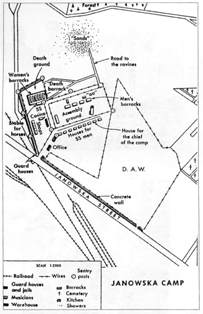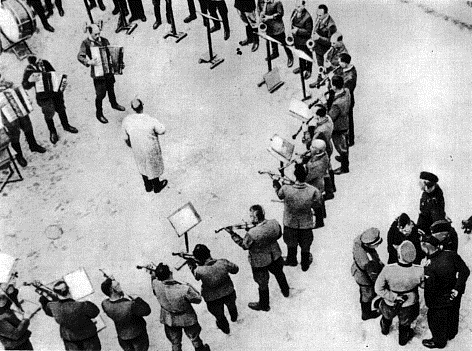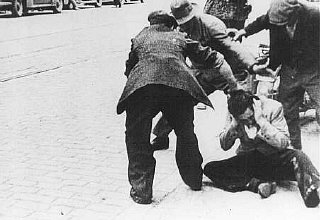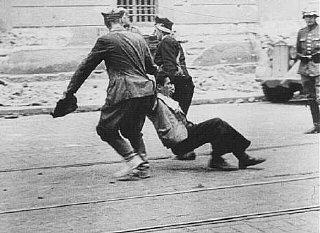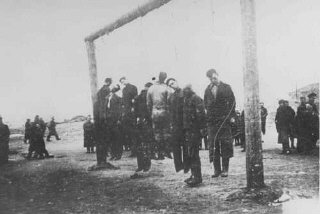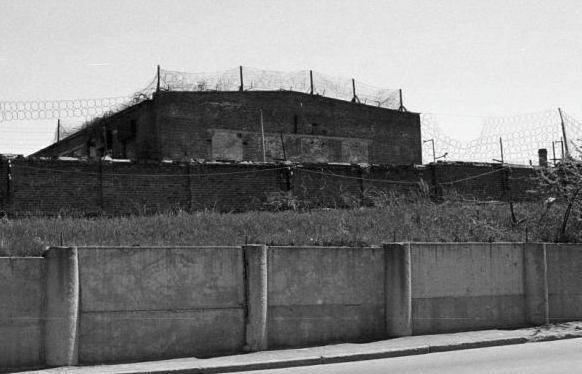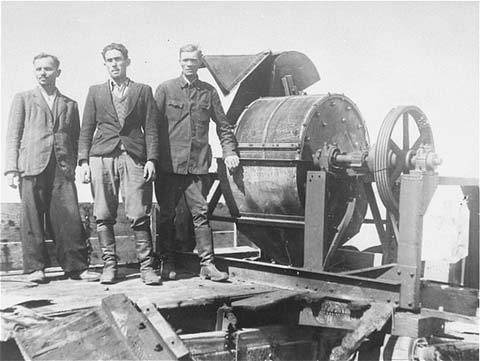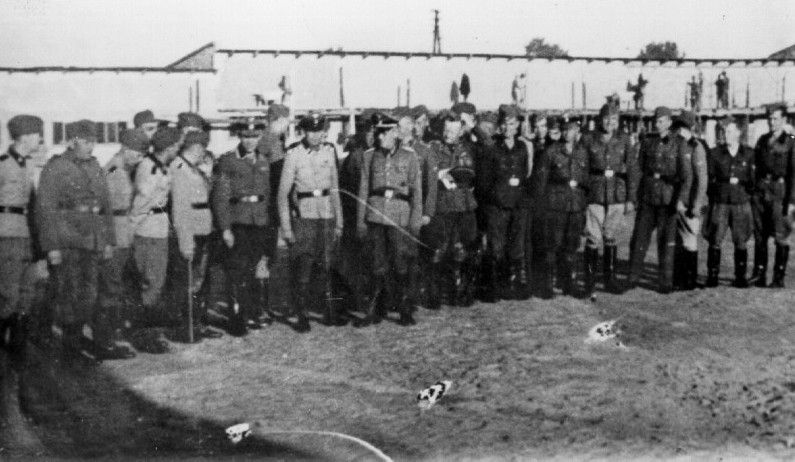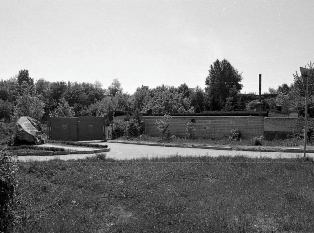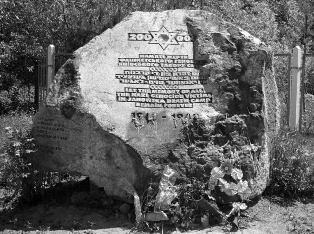Holocaust Education & Archive Research Team |
|
Other Camps
Key Nazi personalities in the Camp System The Labor & Extermination Camps
Auschwitz/Birkenau Jasenovac Klooga Majdanek Plaszow The Labor Camps
Trawniki
Concentration Camps
Transit Camps |
|||
Janowska - Lvov
In September 1941 the Germans set up a factory at 134 Janowska Street in the suburbs of Lvov to service the needs of the German Army. Soon after, they expanded it into a network of factories as part of the German Armaments Works (DAW), a division of the SS. From its inception Jews from Lvov were utilised as forced labourers in these factories and by the end of October 1941, six hundred Jews were working there.
At that point, the character of the factories changed, a forced Jewish labour Camp (Juden- Zwangsarbeitslager) was established. The area became a restricted camp, enclosed by barbed wire, and the Jewish workers were not permitted to leave. The Janowska camp complex consisted of three sections. The first comprised the garages, workshops and offices, with a separate villa for the camp staff, SS/SD and the Ukrainian guards. At the centre of this section stood the villa of the camp commandant
The second section was the camp proper, here barracks, each housing 2,000 inmates, were erected for the Jewish workers. The conditions in the barracks were appalling. Prisoners slept on the ground or on planks. Sanitation was primitive, resulting in permanent conditions of disease and sporadic outbreaks of epidemics. Many prisoners died of starvation – rations consisted of black coffee substitute in the morning, a midday meal of watery soup, containing unpeeled potatoes and 200 grams of bread in the evening.
The third section of the camp consisted of the DAW factories. A barbed wire fence separated the three camp sections from each other, and the entire camp was surrounded with a double barbed-wire fence illuminated with searchlights. Watchtowers were placed all around the camp at fifty meters intervals, with armed Ukrainians and SS men patrolling the perimeter.
The first commander of the camp was Fritz Gebauer, his deputies were Gustav Wilhaus and Richard Rokita, in May 1942 Gebauer took over the command of the DAW camp and Friedrich Warzog was appointed commander of Janowska, with Wilhaus as his deputy. A staff of 12 -15 SS officers, who were replaced from time to time, administered the camp, the guards at the camp were Russian Prisoners of War, who had volunteered for service with the SS.
The camp had originally been planned exclusively for Jews, but after several months a special section was set up for Poles. They were separated from the Jews, received better treatment and were generally released from the camp after a period of detention. In the first months, only Jews from Lvov were brought to the camp, but later on Jews were sent to the camp from other districts including Krakow.
Most of the Jews in the camp came from the East Galician District, and the sub-districts of Rawa- Ruska, Kamionka, Strumilowa, Sambor, Brzezany and Kaluz. The SS men from the camp visited these districts from time to time for extermination actions, and sub-branches of the Janowska camp were also established in Laski Kurowice, Jaktarowe and other places to which some members of the Jewish workforce of the Janowska camp were transferred.
The Jews who were brought to Janowska had to surrender all valuables on arrival. The Jewish prisoners were divided into labour brigades of 20-30 persons. They worked a 12-hour day, both in the camp and in Lvov itself, where they broke up tombstones in the Jewish graveyards, supervised by SS and Ukrainian militia.
The prisoners also worked on various projects organised by the SS, there was a special Jewish Commando engaged in burying the Jewish dead in the camp, particularly those Jews executed on the sand-hills behind the camp. This Commando was also used to sort the clothing and property of the dead. The living conditions in the camp were exceptionally barbaric, many prisoners committed suicide by hanging themselves in the barracks, rather than face another day of cruelty. When they returned from work, the prisoners were made to run into the camp, Warzog and his deputy Wilhaus singled out those Jews who showed signs of fatigue. These Jews were placed between the rows of wire and left there to die. Each morning there was a roll call for all prisoners, who were personally inspected by an SS officer. Any prisoner failing the inspection was immediately shot.
Rokita had a murderous habit when passing through the rows of prisoners on the parade ground, if he did not like a prisoner he would shoot him in the back of the neck. Every SS man had his favourite way of killing Jews in the camp, who were often murdered for the slightest misdemeanour, for working slowly, for not paying attention, some for no reason at all.
The manner in which a Jew was killed varied, depending on the executioner; shooting, flogging, choking, hanging, fixing to crosses with the head down, cutting to pieces with knives or axes. Distinctive procedures were adopted when killing women. They were mostly flogged to death or killed by stabbing. The Nazis conducted their tortures, beatings and shootings to the accompaniment of music.
For this purpose the SS organised a prisoner’s orchestra, led by Professor Stricts and the well-known conductor Mund. Composers were ordered to write a special tune, which was called “The Death Tango.” Shortly before the camp was liquidated the Nazis shot all members of the orchestra.
The Jews working at the Railway station scrubbing and cleaning locomotives, were house in Barrack `Number 5, was the subject of intense SS brutality. This brigade also supplied the largest quotas for executions. On 16 March 1943, following the killing of an SS man by the Jews Kotnowski, thirty members of this work –brigade were summarily shot as a reprisal. A further eleven Jewish policemen were hanged from balconies in the main street of the Lvov Ghetto.
Nearly 1,000 Jews were taken out of other working groups outside the camp and shot. A further 200 Jews in Janowska itself were also shot. During a tour of the General Government by Max von Herff, his aide wrote about a visit to Janowska on 10 May 1943:
"This camp stands on the grounds of an old factory and through the initiative of SS Gruppenfuhrer Katzmann it has grown to its present size. Over 30,000 Jews work in this camp. There is a Jewish Police force who are picked, well-built men with rubber truncheons and a long leather whip.
Time and again one can see how, with the most brutal methods, they drive their own people to work and they feel themselves completely their superiors. It is completely beyond the understanding of German people that among the Jews some of their own men, are the worst slave drivers.
Jewish women who are in charge of various departments and blocks run around with enormous whips to drive their own companions to work and it could be clearly seen that they do their job mercilessly.
The more one sees of Jewish people in these camps, the more one comes to loathe them. They have no composure, no self-esteem and no will to resist, not even passively, no pride, neither in their general bearing or their looks. On the contrary, they give way and try to make the best of the position they are in."
When the mass deportation of Jews from Eastern Galicia to Belzec began in March 1942, the status of the camp was changed yet again- it became a transit camp for Jews from towns and villages in the area. Inside the camp, selections of those considered fit for labour took place, those not selected were transported to the Belzec death camp.
Shortly afterwards Janowska was enlarged and took on the character of a concentration camp, following “actions” in Lvov in the summer of 1942, thousands more Jews were sent to the camp. By mid-1943, whilst still functioning as a labour camp, Janowska was now being turned into an extermination camp. Fewer prisoners were employed in the factories inside the camp and in Lvov and newcomers to the camp, did not stay long.
The executions took place in the Piaski sand-hills behind the camp, there were two slopes on which Jews were shot and then buried in pits. During mid-May 1943 alone, over six thousand Jews were murdered there. Under Gebauer, a savage system of extermination was instituted at the Janowska Camp, and this was continued by Commandant Warzog, and his deputy Wilhaus.
This initiative was regarded as a matter of special merit at Janowska, and horrific atrocities were an everyday occurrence. One unnamed witness told the Soviet Special Commission of Enquiry:
“I saw Gebauer strangle women and children with my own eyes. I saw them place men in barrels of water to freeze in the depth of winter. The barrels were filled with water and then the victims were tied hand and foot and put into the water. The doomed people remained in the barrels until they froze to death.”
Then he would pass the machine-gun to his wife, who also shot at them. On one occasion to please his nine-year old daughter, Wilhaus ordered someone to toss two four year old into the air, while he fired at them. His daughter applauded and cried, “Papa, do it again, papa do it again!” Papa did.
Warzog liked to hang prisoners on poles by their feet, and leave them in this position until they died. Rokita personally ripped open prisoners’ stomachs, Heine the Chief of the Investigation Department within the Janowska camp used to perforate the bodies of prisoners with a spike or iron rod, he would pull out the finger-nails of women prisoners with pliers, undress his victims hang them by the hair and set them swinging, before shooting at the “moving target.”
In Janowska, prisoners were murdered on any pretext, often for a bet. The victims were not always Jewish, the witness Kirschner informed the Soviet Special Commission after the war that Wepke, a Gestapo Commissar, boasted to other camp executioners that he could cut a boy in two parts with one blow of an axe.
His colleagues did not believe him, so he caught a ten year old boy in the street, forced him to his knees, then he made the boy put his palms together to hide his face. Wepke made a trial stroke, adjusted the boy’s head, and with a single blow of the axe slashed him in two. The Nazis congratulated Wepke warmly, and shook him by the hand.
On 2 March 1942, the first day of Purim, six Jews were forced to spend the night outside the barracks, on the grounds that they “looked sick” and should not infect others. The temperature was below freezing point. Leon Wells (Wieliczker) recalled:
“In the morning all six people were frozen lying down where they were put out the night before, completely white like long balls of snow. On 4 March 1942, Gebauer ordered a barrel of water to be brought and picked out eight more labourers from Janowska. The eight Jews were forced to undress and were then placed in the barrel. They remained in the barrel all night – in the morning Wieliczker recalled, “We had to cut the ice away – the men were frozen to death.” In the evening the same officers selected sick Jews and shot them. Gebauer was known for his sadistic strangling abilities. He would select a Jew and strangle him with his bare hands.
On 20 April 1943, Hitler’s fifty-fourth birthday, Wilhaus picked out fifty-four prisoners and personally shot them. In the camp there was a so-called hospital for prisoners – the Nazi executioners Brambauer and Birmann examined the patients on the 1st and 15th of every month. If they found any patients who had been in hospital over a fortnight, they shot them on the spot. Six or seven people were murdered during each such examination. By a miracle Leon Wieliczker survived internment in Janowska twice, once as a prisoner condemned to death and then as a member of the Sonderkommando 1005, whose grisly task was to exhume and burn the corpses of the murdered Jews.
In his testimony during Adolf Eichmann’s trial in Jerusalem in 1961, Wieliczker graphically described how having first dug his own grave in the sand hills of Piaski, he was ordered to fetch the body of a prisoner who had been shot in the camp. Despite a raging fever, which caused him to lag behind his guard, he dragged the body of the dead man towards the execution site. There was a moment when the guard’s back was turned, Wieliczker seized the opportunity to drop the body and disappear into the camp.
The guard knew that he had lost Wieliczker, and was afraid of the reactions of his superiors. Anyone taken to Piaski could never return to the camp, and so the dead man was buried as if he were Wieliczker.
The numbers tallied and Wieliczker was officially dead. This was of vital importance. At that time, escaping from the camp was easy. The problem was that if one prisoner escaped, the SS shot ten people from that person’s brigade and the family and relatives of the escapee were hanged.
Now that he knew that he was officially dead, Wieliczker understood that he could escape without endangering any of his fellow prisoners or his family. And escape he did, only to be subsequently recaptured and returned to Janowska. In June 1943, the 126 man Jewish brigade of Sonderkommando 1005 began the exhumation and cremation
During June 1943, the 126 strong Jewish brigade of Sonderkommando 1005 began the exhumation and cremation of all those who had been murdered and buried in the Lvov district. The German officers in charge of this Kommando were SIPO-SD Scharfuhrer Rauch and SIPO –SD Oberwachtmeister Kepick. The process for this task was that the bodies were recovered from the pits and laid on special platforms in stacks, each containing 1200 – 1600 corpses.
Tar and petrol were then poured over the bodies which were then burned. The ashes and bones were sifted in order to collect articles of value – gold fillings, teeth, rings and watches.
Eyewitness accounts testify that during the five months’ activity of this "Death Kommando" "110 kilogrammes of gold were sifted out of the ashes and dispatched to Germany. The ashes were scattered on the fields or buried; large bones were collected separately and crushed in a bone-crusher, which was specially designed to speed up the "work".
The bone-crusher supervisor was SIPO-SD Scarfuhrer Elitko, surprisingly the Germans failed to destroy this bone-crusher, which was later recovered by the Soviets and used as material evidence at war crimes trials in the Soviet Union.
Wieliczker described in detail the gruesome task of Sonderkommando 1005:
“We used to uncover all the graves where there were people who had been killed during the past three years, take out the bodies, pile them up in tiers and burn these bodies, grind the bones, take out the valuables in the ashes, such as gold teeth, rings and so on – separate them.
After grinding the bones we used to throw the ashes up in the air so that they would disappear, replace the earth on the graves and plant seeds, so that nobody could recognise that there was a grave there. In addition to this they used to bring new people – new victims – they were shot there, undressed beforehand – we had to burn these new bodies too.
When on Tuesday 29 June 1943, two hundred and seventy- five arrived - they were shot with a machine –gun in groups of twenty five. After the first twenty-five stepped into the pit and were shot, the next twenty-five followed.
The 275 that were shot that day explained something that we had found before- there were some graves where it did not seem to us that the people had been shot. Their mouths were open with their tongues protruding.
They were more like people who had suffocated – this told us that these people were buried alive, because when we came to burn the bodies, we found that some of them were only slightly injured due to the machine gun shooting twenty-five people in one burst. So some of them were only slightly injured in the arm and they fell down and were buried beneath the bodies above them. So it happened that this night when we picked up a body and put it in the fire, at the last moment the person started to scream – yell aloud- because they were still alive………..
The Burn Masters were in charge of the fire- when they put up a heap like a pyramid, sometimes up to 2,000 bodies – one had to watch out so that the fire did not go out.
They were in charge of the fire, while the Counters were keeping a count of how many bodies were burnt to check out with the original list – how many were killed, because if we uncovered a grave we were sometimes looking for hours for one body or more if it were buried on the side, there was an exact list of how many people were killed. So the Counter kept the number of bodies burned and taken out of each grave – the report was made with pencil and paper – it was forbidden for anybody to mention the number, and the Zahler himself had to forget.
So that if the Hauptscharfuhrer or Untersturmfuhrer next morning asked, “How many were burned yesterday?” The Counter couldn’t say, he had to reply, “I forgot.”
"We had to make up songs and sing while we were going to wok, and also the Burn Masters would march in front, he was clothed like a devil – he had a special uniform with a hook in his hand and we had to march after him and sing.
Afterwards we were also joined by an orchestra which would play as we sang and accompany us on our march to work. We were told that after eight to ten days we had to be exchanged - we would be shot and another group would come; so when visiting SD men came over to the Death Brigade and asked us how long we had been there it was forbidden for us to say that we had been longer than six, eight, up to eight or ten days - no longer..." The Soviet Special Commission which investigated Nazi crimes after the war, found a number of pits full of bodies of prisoners shot during the second half of July 1944. According to witness testimony and relatives of the murdered people, the Nazis used this place as an execution site for people brought from various Gestapo prisons.
Contrary to their usual practice, the Nazis did not search the clothes of the murdered people, the Soviet Commission found identification papers in the pockets of the clothes of those shot. From these papers the identification papers in the pockets of the clothes of those killed, many of the victim’s identities was established.
The Soviet Special Commission also determined the following:
In common with all of the Nazi killing sites, it is impossible to arrive at a precise total for the number of victims at Janowska, the Commissions investigating these sites immediately after the Second World War generally tended towards over- estimating the numbers murdered there.
Wieliczker testified to the Commission:
“I was a former inmate of the Janowska Camp who was ordered to work in the Blobel – Kommando 1005, compelled to work in this team engaged in exhuming and burning bodies.
I worked from 6 June 1943 to 20 November 1943 – during this time the team burned more than 310,000 bodies, including about 170,000 on the sand-stone of the Janowska Camp, and over 140,000 in the Lisincki Forest. This number includes bodies which were exhumed by the Kommando, as well as those which were not buried, but burned directly after shooting.
"After burning the bodies in the gully, near the Janowska Camp, we were taken at night on trucks to the Lisincki Forest, where we opened 45 pits full of bodies of people who had been shot. From the uniforms, marks of distinction, buttons, medals and orders we identified among the bodies Red Army men, French, Belgian and Italian war prisoners. There were also bodies of civilians among them."
Janowska is still a prison to this day
GFH Private Collections
Sources: The Holocaust by Sir Martin Gilbert, published by Collins, London, 1986 Lvov Ghetto Diary – David Kahane - Univ. of Massachusetts Press, 1991 Soviet Government Statements on Nazi Atrocities – London, 1946 The Trial of Adolf Eichmann – Transcripts - Nizkor Encyclopedia of the Holocaust - Israel Gutman (Ed) - New York 1990. Justice Not Vengeance by Simon Wiesenthal, published by Weidenfeld and Nicolson1989
Copyright Carmelo Lisciotto H.E.A.R.T 2007
|

